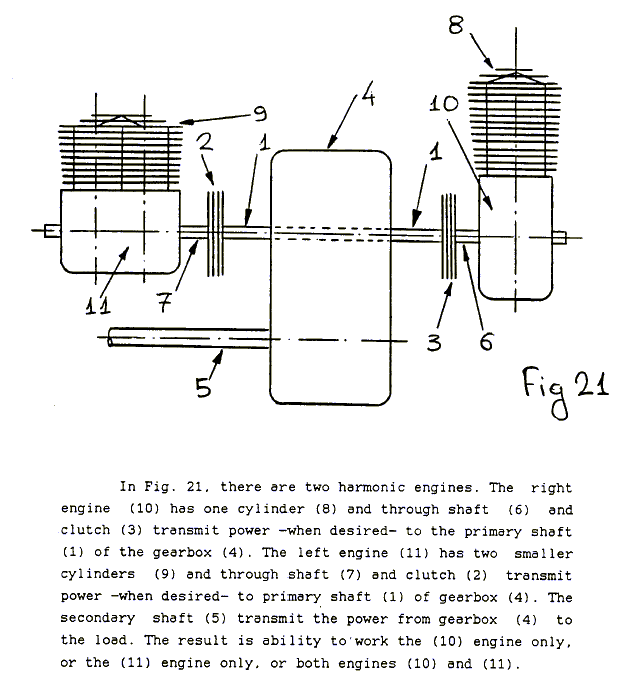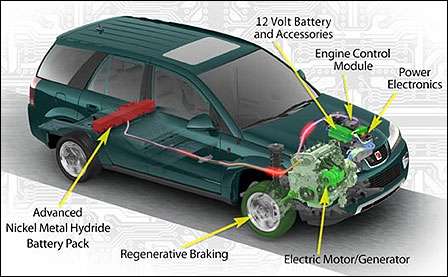A hybrid cannot operate at a better “BSFC” (Kg of fuel / KWh of provided energy) than the peak BSFC of the internal combustion engine it is based on.
The hybrid technology is based totally on the poor BSFC of the internal combustion engine outside a relatively narrow range of revs and loads.
It charges the battery with the engine operating at the efficient revs / loads and then uses the stored energy to move the vehicle.
The inevitable loss of energy (kinetic energy to electric energy, then electric energy to chemical energy into the battery, then chemical energy to electric energy, then electric energy to kinetic energy to move the car for as long as the ICE is turned off) is preferable as compared to the case with the engine operating outside its efficient rev / load range.
An ideal internal combustion engine able to keep the same good thermal efficiency (say 40% which means a BSFC of about 0.210 Kg/KWh) along the whole operating range of revs and loads is not a good base for applying the hybrid technology. With the energy loss during the multiple transformations of energy from the internal combustion engine to, initially, electric energy, then to chemical energy, then back to electric energy and finally to kinetic energy) the hybrid version is difficult to achieve a, say, more than 35% total “BSFC” (0.240 Kg/KWh). Besides the additional cost and complication, the fuel economy and the emissions are way worse as compared to the original car with the “ideal” engine.
The Diesel engine is closer to the abovementioned “ideal” internal combustion engine.
Compare the Volvo 1600cc Diesel with the Toyota Prius. Similar weight and size, similar fuel consumption / emissions in the official urban and extra urban cycles. Is there something that justifies the price difference between the two cars?
Some engine makers try another way: to expand the efficient rev / load range of their conventional gasoline engines. And the results are quite good:
Mazda with their SkyAxtive gasoline engines (constant compression ratio at 14:1, limited Miller cycle, turbocharged),
Nissan with their Micra 1.2 DIG-S (constant compression ratio at 13:1, limited Miller cycle, supercharged),
achieve near to hybrid fuel efficiency without the hybrid cost.
In order to keep the operation of their engines optimized at all conditions, a variable compression ratio – as at
http://www.pattakon....pattakonVCR.htm - would be way better (the peak power of the Mazda SkyActive would double if the compression ratio could drop from 14:1 to 8:1 when plenty of power is necessary). Also a more variable VVA capable for an unlimited Miller cycle – as at
http://www.pattakon....ttakonHydro.htm - would be way better, too.
From another viewpoint (quote from
http://www.pattakon....takonPatPOC.htm ) :
Consider the case of a sport car having a powerful V-8 engine at the one side of the primary shaft of its gearbox (in the place of the 11, Fig 21), and a small green engine (like the single cylinder full balanced PatPOC or PatOP, or like the Fiat 500 TwinAir) at the other end of gearbox primary shaft (in the place of the 10, Fig 21).

The car can go downtown (and anywhere else the driver likes to go economically and environmentally) using its small green engine.
With the coolant from the small engine circulating into the big engine, to keep it warm, the V-8 is ready, any moment, to power the car (with or without the assistance of the green engine).
The vehicle is way more reliable and cheap-to-run and cheap-to-maintain and green.
The big engine design becomes more uncompromised.
And because it doesn’t need to operate at conditions not matching its character, the big engine will last longer (it isn’t rare: an expensive sport car struggling to idle in the bottleneck, with the rest drivers shutting their car windows to keep the noise out).
Compare this solution to the new sport hybrid cars the sport-car makers launch, one by one, in their effort to comply with the present and future emission regulations.
Judging from the 95 gr CO2 / Km, in the combined European cycle, of the 1030Kp heavy Fiat 500 TwinAir, the sport car, any sport car, can be – according the present regulations – as green and fuel efficient as the best hybrid cars, without batteries, without electromotors, without high tech control and without high cost.
Putting a small / efficient internal combustion engine at the free side of the primary shaft of the gearbox of the 20-year-old Honda Accord wagon of the Middle Tennessee State University (instead of the bolt on hybrid system) seems as a better solution. At light loads the small engine is used, at heavier loads the original engine is used, for peak power both engines are used, in case the one engine fails, the car continuous with the other.
On the other hand the hybrid is in fashion.
Thanks
Manolis Pattakos

















